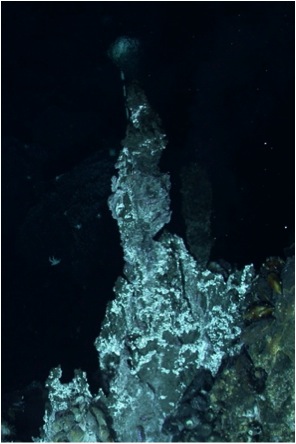
Scientists and crew have been working the past several days at vent sites along the Valu Fa Ridge (VFR), south of the Eastern Lau Spreading Center (ELSC). The VFR is closer to the subduction zone, where the Pacific plate is subducting beneath the Australian plate in the Tonga Trench (east of the VFR). As mentioned in a previous blog post, the composition of the substrate reflects this closer proximity as it is more felsic, indicating the partial melting of oceanic crust in the mantle below the VFR.

Most of our time has been spent at the Mariner site which is approx. 1910 m deep. Hydrothermal chimneys here are much taller than at other sites, e.g. 27 meters, which makes exploring this site much more treacherous (see top photo). Vent fluids at Mariner are hotter and more acidic (pH 2.6-2.8) than those at the vent fields to the north. The hottest temperature recorded so far on the cruise (369˚C) was measured here at a vigorously venting black smoker (see photo above). The increased acidity at Mariner makes it ideal for culturing thermoacidophiles (heat and acid loving microbes). Mariner is also home to many fewer animals than other vent sites we've visited. We observed mainly shrimp (see photo below) but did not see any snails.
 In addition to collecting many samples of sulfide chimneys, two arrays have been successfully deployed here.
In addition to collecting many samples of sulfide chimneys, two arrays have been successfully deployed here. We also visited the Vai Lili vent site, where scientists sampled microbial mats rather than sulfide chimneys. Microbial mats are dense accumulations of microbes, so thick that they resemble a mat. In the photo below, we were measuring the temperature at the bottom of the yellow mat, which was 48˚C.
We also visited the Vai Lili vent site, where scientists sampled microbial mats rather than sulfide chimneys. Microbial mats are dense accumulations of microbes, so thick that they resemble a mat. In the photo below, we were measuring the temperature at the bottom of the yellow mat, which was 48˚C.


